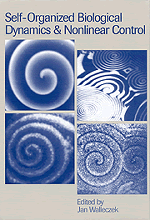 Self-Organized Biological Dynamics and Nonlinear Control
Self-Organized Biological Dynamics and Nonlinear Control Book contents
- Frontmatter
- Contents
- List of contributors
- Preface
- The frontiers and challenges of biodynamics research
- Part I Nonlinear dynamics in biology and response to stimuli
- Part II Nonlinear sensitivity of biological systems to electromagnetic stimuli
- Part III Stochastic noise-induced dynamics and transport in biological systems
- Part IV Nonlinear control of biological and other excitable systems
- 14 Controlling chaos in dynamical systems
- 15 Electromagnetic fields and biological tissues: from nonlinear response to chaos control
- 16 Epilepsy: multistability in a dynamic disease
- 17 Control and perturbation of wave propagation in excitable systems
- 18 Changing paradigms in biomedicine: implications for future research and clinical applications
- Index
15 - Electromagnetic fields and biological tissues: from nonlinear response to chaos control
Published online by Cambridge University Press: 14 August 2009
- Frontmatter
- Contents
- List of contributors
- Preface
- The frontiers and challenges of biodynamics research
- Part I Nonlinear dynamics in biology and response to stimuli
- Part II Nonlinear sensitivity of biological systems to electromagnetic stimuli
- Part III Stochastic noise-induced dynamics and transport in biological systems
- Part IV Nonlinear control of biological and other excitable systems
- 14 Controlling chaos in dynamical systems
- 15 Electromagnetic fields and biological tissues: from nonlinear response to chaos control
- 16 Epilepsy: multistability in a dynamic disease
- 17 Control and perturbation of wave propagation in excitable systems
- 18 Changing paradigms in biomedicine: implications for future research and clinical applications
- Index
Summary
Introduction
Between regularity and randomness lies chaos. Our prevailing scientific paradigms interpret irregularity as randomness. When we see irregularity, we chauvinistically cling to randomness and disorder as explanations. Why should this be so? Why is it that, when the ubiquitous irregularity of biological systems is studied, instant conclusions are drawn about randomness and the whole vast machinery of probability and statistics is belligerently applied? Recently we have begun to realize that irregularity is much richer than mere randomness can encompass. Thus, we are brought to chaos.
Sustained irregularity has always upset our notions of how the world should behave. Yet it seems to be the canonical behavior of biological systems. One informal definition of chaos, sustained irregular behavior, although descriptive, is too vague to define the rich behavior of chaotic systems. A more precise defining feature of chaotic systems is their sensitivity to initial conditions (e.g., see Baker and Gollub, 1990). It is this definition that we will utilize for the characterization and control of chaotic systems.
Fleeting glimpses of order within disorder are quite common. We have all seen short stretches of almost periodic behavior in otherwise irregular systems. A tantalizing example lies in the stock market, where many hope to reap windfall fortunes from analyzing short-term order and predicting the volatile market. But short-term order is a profound, even defining, feature of chaotic systems.
- Type
- Chapter
- Information
- Self-Organized Biological Dynamics and Nonlinear ControlToward Understanding Complexity, Chaos and Emergent Function in Living Systems, pp. 341 - 373Publisher: Cambridge University PressPrint publication year: 2000
